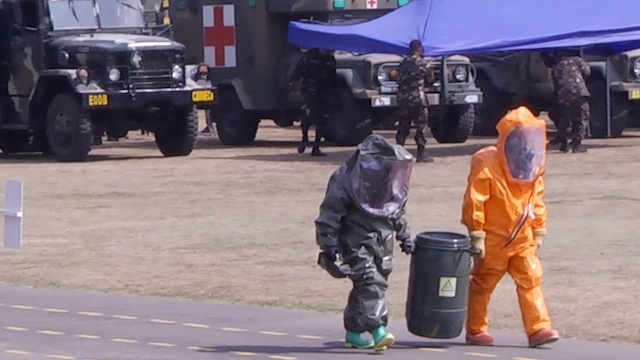
NEW UNIT FOR NEW THREATS: Members of the military's CBRNE unit. Photo by Carmela Fonbuena/Rappler.com
The Armed Forces of the
The 4-month old
CBRNE unit is initally composed of a 30-man platoon pulled out of the Army's
Explosive Ordnance And Disposal (EOD) battalion. They were trained to respond
to the most demanding emergies of all – terrorist attacks.
A scenario of a
chemical attack was enacted inside the military headquarters in Quezon City
The plan is to
grow the CBRNE unit and deploy them nationwide. The training and equipment are
expensive, however.
"This is
just the start of building up our own capability. We have started it and we
will improve on it. We will come up with a bigger unit. We will acquire more
equipment to improve the capability of this unit," said Major General
Danilo Servando, chief of the Army Support Command.
Various
attacks
Terrorist
networks are present in the Philippines
In 2004, local
terrorists bombed a Philippine superferry. It is the biggest maritime terrorist
attack in Philippine history. The following year, in 2005, a bus exploded on
Valentines Day in Makati
City
There was also
the Tokyo Syria
Terrorist threats
nowadays include human bombs, liquid bombs, printer bombs, underwear bombs, and
bombs surgically implanted in the bodies of terrorists.
In 2013, there
was the Boston Marathon attack that
used pressure cooker bombs.
"In our
case, where we actively used this as a means of containment is our deployment
in the United Nations. If you remember we had a threat of a chemical attack in
our deployment in Golan Heights that prompted
us to have more protection equipment because the threat is real," said
Armed Forces spokesperson Lieutenant Colonel Ramon Zagala.
The Philippines
"From the
deterrence point of view, they are looking for new methods to attack us. When
we become more aware on explosive sectors, they start looking for other
markets, for example anthrax and other biological and chemical substances as
well," Salim said.
http://www.rappler.com/nation/52340-cbrne-terrorist-attacks-response

No comments:
Post a Comment
Note: Only a member of this blog may post a comment.